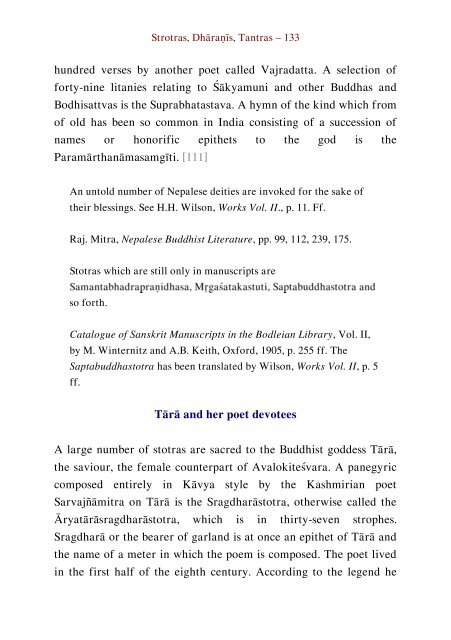Literary History of Sanskrit Buddhism
A study by J. K. Nariman of Sanskrit Buddhism from the Early Buddhist Tradition up to the Mahayana texts proper.
A study by J. K. Nariman of Sanskrit Buddhism from the Early Buddhist Tradition up to the Mahayana texts proper.
Create successful ePaper yourself
Turn your PDF publications into a flip-book with our unique Google optimized e-Paper software.
Strotras, Dhāraṇīs, Tantras – 133<br />
hundred verses by another poet called Vajradatta. A selection <strong>of</strong><br />
forty-nine litanies relating to Śākyamuni and other Buddhas and<br />
Bodhisattvas is the Suprabhatastava. A hymn <strong>of</strong> the kind which from<br />
<strong>of</strong> old has been so common in India consisting <strong>of</strong> a succession <strong>of</strong><br />
names or honorific epithets to the god is the<br />
Paramārthanāmasamgīti. [111]<br />
An untold number <strong>of</strong> Nepalese deities are invoked for the sake <strong>of</strong><br />
their blessings. See H.H. Wilson, Works Vol. II., p. 11. Ff.<br />
Raj. Mitra, Nepalese Buddhist Literature, pp. 99, 112, 239, 175.<br />
Stotras which are still only in manuscripts are<br />
so forth.<br />
Catalogue <strong>of</strong> <strong>Sanskrit</strong> Manuscripts in the Bodleian Library, Vol. II,<br />
by M. Winternitz and A.B. Keith, Oxford, 1905, p. 255 ff. The<br />
Saptabuddhastotra has been translated by Wilson, Works Vol. II, p. 5<br />
ff.<br />
Tārā and her poet devotees<br />
A large number <strong>of</strong> stotras are sacred to the Buddhist goddess Tārā,<br />
the saviour, the female counterpart <strong>of</strong> Avalokiteśvara. A panegyric<br />
composed entirely in Kāvya style by the Kashmirian poet<br />
Sarvajñāmitra on Tārā is the Sragdharāstotra, otherwise called the<br />
Āryatārāsragdharāstotra, which is in thirty-seven strophes.<br />
Sragdharā or the bearer <strong>of</strong> garland is at once an epithet <strong>of</strong> Tārā and<br />
the name <strong>of</strong> a meter in which the poem is composed. The poet lived<br />
in the first half <strong>of</strong> the eighth century. According to the legend he


















